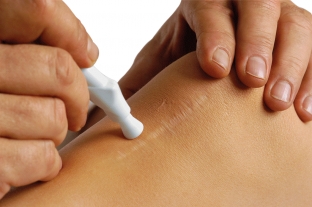Almost every day, human skin, which is the main protective barrier of the body, is exposed to various damaging agents, which manifests itself in a certain reaction. Experts know that the violation of the integrity of the superficial layers of the skin is eliminated quite quickly and almost without a trace, while damage to the deep layers heals with the formation of scars. In this article, estet-portal.com talks about how atrophic and normotrophic scars differ from other types of scarring, as well as about the most effective methods of scar treatment.
The most effective cosmetic treatments for scars
The process of healing the skin after deep injuries is almost always accompanied by the formation of scar tissue.
There are several types of scars: keloid, hypertrophic, normotrophic and atrophic.
Depending on how the skin fibroblasts cope with their main task and how much they produce elastin and collagen fibers, the type and condition of the formed scar depends. The choice of scar treatment method depends on the type of skin scarring. Keloid and hypertrophic scars are voluminous and protrude above the skin, atrophic – sunken, and normotrophic are located on the same level with the skin.
Scar treatment methods:
- normotrophic and atrophic scars: structural features;
- effective methods of treating normotrophic scars;
- effective methods of treating atrophic scars.
Normotrophic and atrophic scars: structural features
Very many patients with scars on their skin turn to aesthetic medicine specialists for help. In order to choose the right scar treatment method, it is necessary to determine what type of scarring the patient has:
- normotrophic scars – this is the most favorable option for healing deep skin lesions. Such scars are pale in color, located on the same level with the skin and are almost invisible on it. It is recommended to remove them only in cases where the defects are on the open parts of the patient's body, are large and cause discomfort to the person;
- Atrophic scars are formed in places where the skin is stretched or affected by inflammation. They have a sunken appearance and a pale or light pink color, and are also characterized by loose skin in the area of the scar.
Effective treatments for normotrophic scars
Modern cosmetology offers a fairly large number of scar treatment methods that are located on the same level with the skin:
- peelings – make it possible to remove epidermal cells and even out the relief of the skin;
- microdermabrasion – means skin resurfacing with a special nozzle with micro-diamond microcrystals;
- topical application of products that contain biologically active substances and enhance microcirculation, affect the processes of collagen production and eliminate formed scars;
- cryotherapy – ultra-low temperatures affect vascular tone and accelerate trophism and tissue metabolism processes;
- operative dermabrasion – this is the use of a laser or deep mechanical resurfacing with a Schumann-Schreus cutter to eliminate normotrophic scars.

Effective treatments for atrophic scars
Among the most effective treatments for atrophic scars, the following are distinguished:
- peelings – superficial to deep, depending on the depth of the formed scar;
- microdermabrasion – a special nozzle that creates a vacuum in the place where the scar is located, knocks out particles of the skin and the scar itself, damaging the tissues for their subsequent replacement with new cells;
- use of agents that stimulate collagen synthesis;
- mesotherapy promotes the activation of fibroblasts and active collagen synthesis;
- subcision – this is the cutting of connective tissue fibers, which determine the formation of an atrophic scar.
The choice of an effective method of scar treatment depends primarily on the type of scarring observed in a particular patient.
On estet-portal.com read other materials about effective methods of treating scars and scars. Thank you for staying with us!







Add a comment